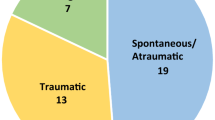Abstract
Cerebrospinal fluid (CSF) rhinorrhea occurs when there is a communication between subarachnoid space and sinonasal mucosa due to meningeal, osseous and mucosal defects in the cranial base leading to discharge of CSF from the nose. The risk of developing meningitis after CSF rhinorrhea may vary from 5.6 (Leech and Paterson in Lancet 1:1013–1016, 1973) to 60% (Eljarnel and Foy in Br J Neurosurg 5:275–279, 1991). Hence surgical management of CSF rhinorrhea is highly recommended. Transnasal endoscopic approach first described by Wigand in 1981, has been proven to be the approach of choice in comparison to intracranial and external nasal approach (Jones and Becker in Br Med J 322:122–123, 2001) in most cases. The next defining milestone was the pedicled naso septal vascularized flap described by Hadad et al. (Laryngoscope 116(10):1882–1886, 2006), which could be used to manage large defects. In the present study we assessed 243 cases of CSF rhinorrhea managed by transnasal endoscopic approach. We compared the various factors associated with CSF rhinorrhea and the correlation with the outcome of the surgical treatment. We also analyzed the different sites and techniques of surgical repair and have certain recommendations to improve the surgical outcome. The commonest cause of CSF leak was spontaneous (54.32%) and the commonest site was cribriform plate (43.24%). Patients presented most commonly with watery nasal discharge (82.3%). CT scan with cisternography or MR cisternography is the gold standard to identify the suspected site of leak. Out of 243 patients, 77.77% were operated using free grafts and 22.22% by flap repair. Results are comparable. Hence we would advise simple conservative technique with free grafts to reduce morbidity and shorten the postoperative recovery.
Similar content being viewed by others
References
Leech PJ, Paterson A (1973) Conservative and operative management for cerebrospinal-fluid leakage after closed head injury. Lancet 1:1013–1016
Eljarnel MS, Foy PM (1991) Nontraumatic CSF fistulae: clinical history and management. Br J Neurosurg 5:275–279
Hadad G, Bassagasteguy L, Carrau RL, Mataza JC, Kassam A, Snyderman CH, Mintz A (2006) A novel reconstructive technique after endoscopic expanded endonasal approaches: vascular pedicle nasoseptal flap. Laryngoscope 116(10):1882–1886
Hegazy HG, Carrau RL, Snyderman CH, Kassam A, Zweig J (2000) Transnasal endoscopic repair of cerebrospinal fluid rhinorrhea: a meta-analysis. Laryngoscope 110:1166–1172
Marshall AH, Jones NS, Robertson IJA (1999) An algorithm for the management of CSF rhinorrhea illustrated by 36 cases. Rhinology 37:182–185
Dodson EE, Gross CW, Swerdloff JL et al. (1994) Transnasal endoscopic repair of cerebrospinal fluid rhinorrhea and skull base defects: a review of 21 cases. Otorhinolaryngol Head Neck Surg 111:600–605
Lanza DC, O’Brien DA, Kennedy DW (1996) Endoscopic repair of cerebrospinal fluid fistulae and encephaloceles. Laryngoscope 106:1119–1125
Burns JA, Dodson EE, Gross CW (1996) Transnasal endoscopic repair of craniofacial fistulae: a refined technique with long term followup. Laryngoscope 106:1080–1083
Gjuric M, Goede U, Keimer H, Wigand ME (1996) Endonasal endoscopic closure of cerebrospinal fluid fistulas at the anterior cranial base. Ann Otol Rhinol Laryngol 105:620–623
Wormald PJ, McDonogh M (1997) “Bath-plug” techniques for the endoscopic management of cerebrospinal fluid leaks. J Laryngol Otol 111:1042–1046
Mirza S, Thaper A, McCleelland L, Jones NS (2005) Sinonasal cerebrospinal fluid leaks: management of 97 patients over 10 years. Laryngoscope 115:1774–1777
Jones NS, Becker DG (2001) Advances in management of CSF leaks, new techniques will improve the management of unilateral clear nasal discharge. Br Med J 322:122–123
Kelley TF, Stankiewicz JA, Chow JM, Origitano TC, Shea J (1996) Endoscopic Closure of postsurgical anterior cranial fossa cerebrospinal fluid leaks. Neurosurgery 39:743–746
Milford CA (1997) In: Mackay IS, Bull TR (eds) Scott Brown’s otorhinolaryngology, vol 4, 6th edn. Rhinology. Buttersworth-Heinemann Publishers, Boston, pp 4/14/1–4/14/12
Mattox DE, Kennedy DW (1990) Endoscopic management of cerebrospinal fluid leaks and cephalocele. Laryngoscope 100:857–862
Dodson EE, Gross CW, Swerdloff JL, Gustafson LM (1994) Transnasal endoscopic repair of cerebrospinal fluid rhinorrhea and skull base defect: a review of 29 cases. Otorhinolaryngol Head Neck Surg 111:600–605
Slankiewicz JA (1991) CSF fistula and endoscopic sinus surgery. Laryngoscope 101:250–256
Schaefer SD, Manning S, Close CG (1989) Endoscopic paranasal sinus surgery: indications and considerations. Laryngoscope 99:1–5
Kirtane MV, Gautham K, Upadhyaya SR (2005) Endoscopic CSF rhinorrhea closure: our experience in 267 cases. Am Acad Otorhinolaryngol Head Neck Surg 132:208–212
Gassner HG, Jens U et al (1999) CSF rhinorrhea: 95 consecutive surgical cases with long term follow up at the Mayo clinic. Spring Meeting of the American Rhinologic Society. 25–26 April 1999
Acknowledgements
We would like to thank Dr. R. V. Patil, Medical Director of Bombay Hospital for allowing us to publish hospital Medical data. We would also like to thank the department of neurosurgery with whose help and support all these patients were operated.
Author information
Authors and Affiliations
Corresponding author
Ethics declarations
Conflict of interest
The authors declare that they have no conflict of interests.
Additional information
Publisher's Note
Springer Nature remains neutral with regard to jurisdictional claims in published maps and institutional affiliations.
Rights and permissions
About this article
Cite this article
Shah, N., Rao, M. Analysis of Various Factors and Techniques to Improve Outcome of Surgical Management of 243 Cases of CSF Rhinorrhea. Indian J Otolaryngol Head Neck Surg 71, 201–205 (2019). https://doi.org/10.1007/s12070-018-01579-6
Received:
Accepted:
Published:
Issue Date:
DOI: https://doi.org/10.1007/s12070-018-01579-6




